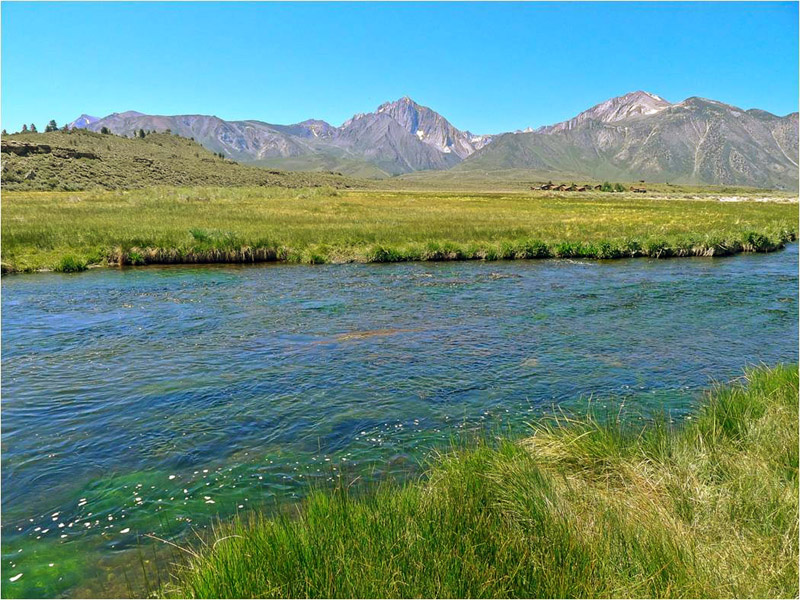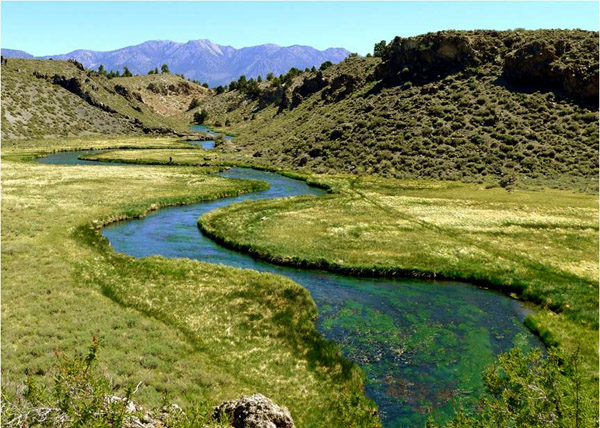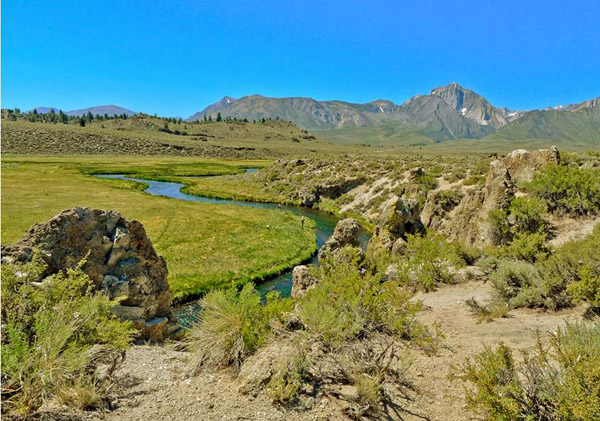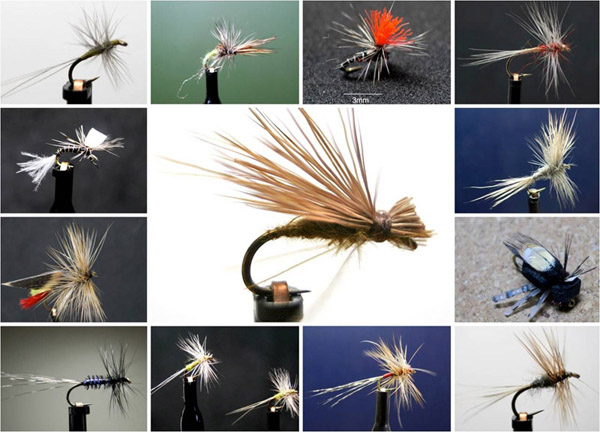Sometimes traditional saves the day – Hot Creek in the Eastern Sierras in California
Text and photographs by Hugh Rosen
Earlier this month I was lucky enough to share a trip to Hot Creek Ranch in the California Sierras with my friend and colleague “The Professor”. Hot Creek Ranch is a spring creek rising at about 7000 foot elevation on the Eastern slope of the Sierras east of Yosemite. Set in the bowl of the high Sierras, and surrounded by small meadows rapidly giving way to hills covered in high desert chaparral, with sandy soil and the characteristic smell of creosote, the Ranch is about a 400 mile drive from my home in San Diego, passing through the quaint Mojave desert mining ghost towns of Randburg and Johannesburg, that were founded by miners who had learnt their trade on the Witwatersrand.

Hot Creek looking towards the cabins
Hot Creek Ranch has 9 cabins, and only those staying there can fish the 350 acres of the ranch. It has been barbless dry fly only, no wading and catch and release for more than 70 years. The water is crystal clear and with plant growth reminiscent of the ranunculus beds of English chalk, in a landscape archetypically Western.
The trout population is wild rainbows and browns, abundant and challenging enough to skunk the undetermined, the unobservant and the poor presenters.I would never, of course, comment on size, especially with regard to the size actually landed. In addition, the wind picks up in the afternoon and can blow like the “Cape Doctor” at its best. Insect life is abundant and tends to the small (Kevin Peterson who runs the ranch doesn’t have any flies bigger than #16, and sometimes painfully small may be needed).
Being a spring creek, hatches and feeding patterns change unobtrusively (PMDs, baetis, little caddis and the troublesome midges) and there are brief periods where one solves the biology, followed by lengthy hours of not getting it at all. All this with a very small winter snow pack and the challenge of low water, required tippets of 6-7X and long leaders. All in all, a combination of interesting company, an amazing ecosystem and good fishing that only the grumpiest misanthrope could fail to enjoy.

Views of the Ranch waters from the little hill

I had tied parachute Adams (18-24), parachute PMDs in 18-22, Klinkhammers in all sorts of sizes, Brooks sprout midges and all the prescribed, expected patterns, and they were inspected and ignored.
However, the old dependables really delivered. Many of my flies are tied after Richard Ward’s Derbyshire Flybox, http://dryflyexpert.blogspot.com/2012/04/fly-box.html , without wings and the hackle tied in at the eye and wound backwards, with the thread coming back through to the whip finish. They are robust, durable and present really well.

A Hat Creek fly collection
The Tupp’s Indispensable replicated the PMD hatch, while the Double Badger tied in an 18 with Silver Badger hackles was wonderful at bringing trout to the surface when all was quiet, as long as the drift was within 2 inches of the bank. Brownies in particular rose freely to the Double Badger. It turned out to be much better in my hands than a Griffiths gnat or other midge mimic.
For the caddis, either a CDC and elk hair in 20 or 22, or the eponymous Hot Creek Caddis (grey CDC body, elk hair wing and blue dun parachute hackle in a 20-22 did the trick. A BWO cripple did better than any other pattern for the baetis, and when the wind was strong, a bullet-head caddis, a foam beetle and a RAB variant (#18) came to the rescue. The RAB, tied with coq-de-leon tail, stripped peacock, true cree hackle and some 30 year-old legal heron herl (that I usually use for Kite’s Imperials) for the legs worked well in the breeze, bringing warm memories of fish missed and sometimes taken and friends enjoyed on far-off Cape streams.

Did the Professor and I catch some fish? Well he certainly did. I caught a few but were I to be asked about either size or number, I can only quote my other friend “Die Dominee” whose response is always “As ek moet sê, dan moet ek lieg!”.

Hugh Rosen is Professor of Chemical Physiology & Immunology at The Scripps Research Institute in La Jolla California. After studying at UCT, he trained in immunology in Oxford. He works at the interface of chemistry and biology and uses small organic molecules to define control points in physiology and pathology. One molecule synthesized in the lab is about to enter Phase II clinical trials for relapsing, remitting MS.


